New media projects at Yuendumu
Intercultural engagement and self-determination in an era of accelerated globalization, by Melinda Hinkson
This is a republished version of Melinda Hinkson (2002) 'New Media Projects at Yuendumu: Inter-cultural engagement and self-determination in an era of accelerated globalization', Continuum: Journal of Media & Cultural Studies, 16:2, 201-220
Re-reading this essay two decades after its publication I am struck by the extent to which a certain tendency I identified at play in Warlpiri life in the mid-1990s has since rapidly accelerated.
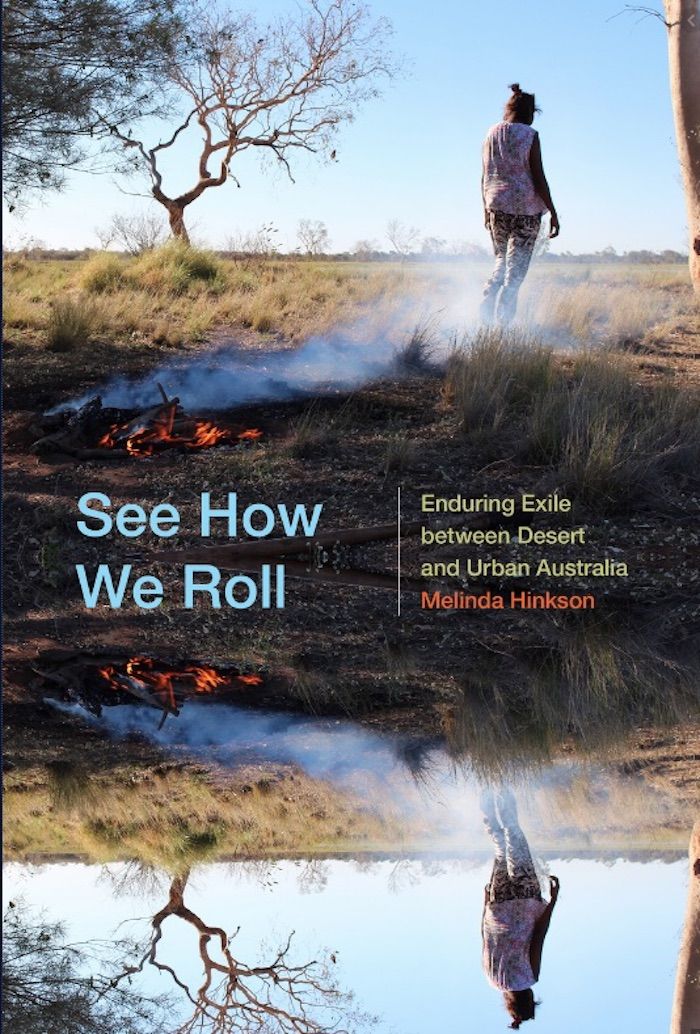
I write these notes just a few months in advance of the publication of my most recent ethnographic project with Warlpiri, a work I describe as a displacement ethnography, See How We Roll: Enduring Exile between Desert and Urban Australia (Duke University Press, 2021).
That book tracks two and half decades of transformations in Warlpiri life and Australian governance through the intimate prism of a close friendship. Its primary focus is on transformations in the life of a woman from the desert who is making a new situation for herself, having been displaced from her hometown. Notwithstanding the speculative questions with which my Continuum essay ends, I could not have envisaged this particular life story playing out at that time. How quickly things change. A vital mediation of the displacement I write about is the mobile phone. Phones are lost many times over, they often run out of credit, and they are utterly essential for keeping in contact with kin. The interactions enabled by the phone—as well as the music it plays, the repositories of photographs and video clips it holds, its opening to the space of social media—in turn provide essential grounding for persons navigating the turbulence of displacement.
In my exploration of various dimensions of Warlpiri sociality in 2002 I gave remarkably little attention to kinship as the primary force through which all activity—mediated or not—turns. In the two decades that have followed, a confluence of factors has brought new scrutiny to Aboriginal kinship. In the context of a comprehensive shift in government policy away from ‘self-determination’ to an approach that is sometimes described as ‘normalising’ or ‘neo-assimilation’ or ‘re-colonising’, the primacy of kinship has often been identified as a key troubling factor in Aboriginal people’s failure to achieve successful lives. New biopolitical technologies such as the BasicsCard—which quarantines welfare payments for expenditure at particular outlets—have been invented to decisively intervene in the social dynamics of kin-based distribution of cash.
Here we are drawn back to Eric Michaels’ prescient warning regarding the devastating implications of Warlpiri being given no choice but to embrace a thinned out ‘lifestyle’ cultural future. It is such a future that Australian federal government policy offers desert people.
Distinctive place-based ways of reckoning value and organising priorities have been explicitly under fire in Australia since 1996 when the Howard government came to power, promising a new era in indigenous governance. The semblance of control Michaels passionately argued for has been filleted away, layer by layer—the end of bilingual schooling; the dissolution of the permit system with which traditional owners once exercised a modicum of control over visitors to their lands; the disbandment of community government councils and their replacement with new centralised bodies governing massively expanded spatial jurisdictions with no Warlpiri logic; the rendering illegal of the practice of customary law; a massive escalation of policing; the introduction of a punitive mutual obligation welfare system… Across the same period, the terms of indigenous politics have been shifting accordingly. Attention to national level campaigns for constitutional recognition has replaced an earlier focus on land and community representation and development. In the meantime, Warlpiri daily life is punctuated by a ceaseless cycle of premature deaths, chronic illness, hunger, stress, and increasing rates of incarceration and punitive surveillance. Mobile media play an essential contradictory role in these circumstances—they are at once vehicles that support hypermobile lives across significant distance, they enable people to evade and be tracked by state authorities, they offer one kind of means by which distancing from homeland and family might be overcome.
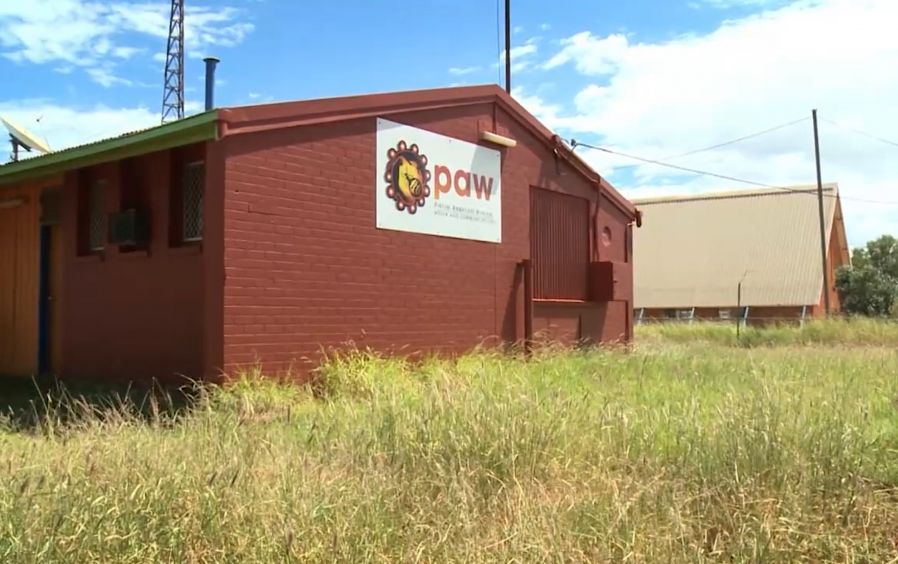
PAW building 2014 (© PAW)
Across this period of accelerating change, the activity about which Eric Michaels wrote with such energy, insight and passion marks a momentous time. A time of fresh thinking, new creative partnerships and considerable hope. The legacy of that time lives on in the Pintupi Anmatyerre Warlpiri Media Association (PAW Media), its remarkable and ever-growing archive, and the generations of Warlpiri who continue to be enthusiastically drawn into new forms of cultural production. Media might well provide valuable windows onto a changing world, but they are also the circuits through which people increasingly wrestle with the multiple pressure points in their lives.
Since the mid–1980s Australian indigenous peoples’ engagements with new media technologies have attracted considerable interest from scholars working in the fields of cultural studies, media studies, and, to a lesser extent, anthropology. In this article I revisit one set of developments which has come to serve as an important grounding point in this body of writing, the innovative use of new communications technology by Warlpiri people at Yuendumu, central Australia. Aspects of this activity are familiar to long-standing readers of Continuum, largely through the writings of the late Eric Michaels and those who subsequently took up his findings [1]. Michaels’ work was important in establishing a whole way of speaking about indigenous media practice, a discursive frame that extended out from Yuendumu to encompass activity occurring across the breadth of remote indigenous Australia. At the centre of this discursive frame sit the concepts of political resistance and cultural maintenance. While such concepts continue to have considerable currency in discussions about indigenous media practice in Australia, I shall argue that in relation to Yuendumu, and I suspect other places, their use is misleading in key respects.
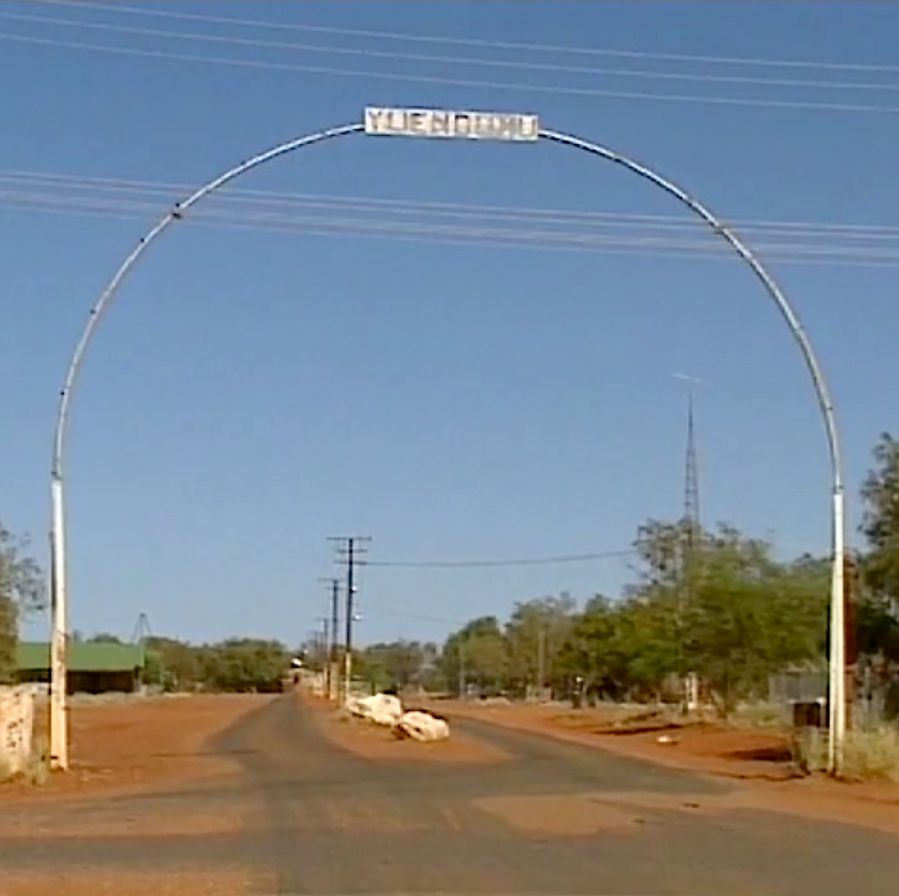
Yuendumu, from Satellite Dreaming, 1991
Revisiting this arena of cultural practice and its representation in this journal seems appropriate and timely for a number of reasons. It is now two decades since Michaels took up his research at Yuendumu. Significant developments have occurred in that township subsequent to the completion of that research and Michaels’ untimely death. Moreover, Michaels’ research into Warlpiri people’s utilisation of new media coincided with a particular moment in the ever-evolving process of globalisation and the conceptualisation of that process by cultural theorists. Both globalisation and the debates concerned with its implications for cultural difference have expanded considerably over that timeframe. Finally, Michaels’ discussion of Warlpiri people’s engagement with new media was partly fuelled by his advocacy of a particular model of self-determination. In a newly emergent discourse that incorporates Aboriginal and non-Aboriginal writers, as well as commentators of both the political left and right, there are calls for a major critical reformulation of that policy framework. For all these reasons it seems timely to revisit Eric Michaels’ analysis of and concerns regarding the introduction of new media to ‘remote’ Aboriginal Australia.
In this article I wish to do three things. Firstly, I will briefly revisit the central findings of Eric Michaels’ research and recall his predictions of what the introduction of new media such as television into Warlpiri social life was likely to entail. Secondly, I will briefly explore the major media developments that have occurred at Yuendumu in the years since Michaels was working there. Finally, in pointing to what I see as the limitations of Michaels’ analysis, I will offer the beginnings of an alternative way of thinking about Warlpiri people’s continuing motivation for engagement with new visual media and communications technology in an era of accelerated globalisation.
At the outset I acknowledge that I have a one-sided advantage in this discussion. Eric Michaels cannot respond, and no doubt his response would have been lively. I also acknowledge that it is far easier to offer critical commentary on another’s work with the benefit of hindsight than it is to charter new territory oneself. Clearly Eric Michaels charted new territory; he opened up our thinking regarding the interplay between new media, globalisation and cultural difference. My comments are offered a decade and a half after his death, and in a spirit of critical engagement I am sure Michaels would have approved of.
In the early 1980s, before television was accessible to most of ‘remote’ Australia, residents of a number of Aboriginal townships were producing their own videos of local events. For Aboriginal people these videos provided alternative and supplementary viewing material to the tapes they could borrow or rent from non-Aboriginal residents or video retail outlets in regional centres such as Alice Springs. One township where such activity was occurring was Yuendumu, 300 kms north-west of Alice Springs in central Australia, with a highly mobile population of some 900 predominantly Warlpiri-speaking Aboriginal people and 100 whites [2]. At Yuendumu local video production preceded the establishment of a ‘pirate’ television station in April 1985. A new organisation, the Warlpiri Media Association, was incorporated to oversee local media activity. Established as the federal government was preparing to launch AUSSAT [3], Warlpiri Media became a rallying point for the concerns and interests of Aboriginal people from Yuendumu and surrounding areas, regarding the launch of the satellite and the arrival of national television. The activity of those associated with Warlpiri Media at Yuendumu in the 1980s laid the groundwork for a number of subsequent developments. Most notable among these was the establishment of the Tanami Network, the first publicly accessible and Aboriginal-owned video conferencing facility in the Northern Territory.
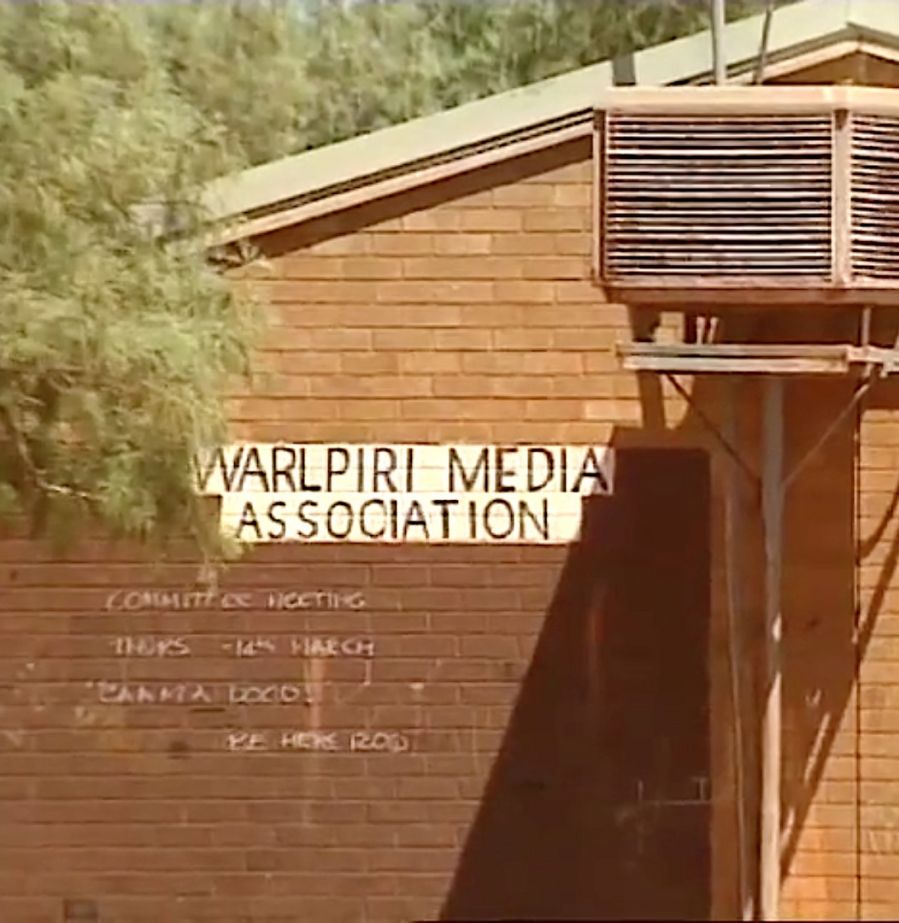
Still from Satellite Dreaming
The first stage in this history is relatively well known, indeed the Warlpiri Media Association has attained an unusually high profile for a small Aboriginal media association, largely through the writings of the late Eric Michaels. Michaels, an American researcher, was appointed by the then Australian Institute of Aboriginal Studies [4] in 1982 to assess ‘the impact’ of introducing television to remote Aboriginal Australia (Michaels 1986). His published works (see especially Michaels 1994) depict what he saw as a culturally distinctive Warlpiri approach to video production and viewing, and a series of associated concerns regarding the implications of ‘mass’ media being integrated into Warlpiri people’s daily lives. His descriptions of Warlpiri cultural resilience in the face of massive social change had wide appeal, particularly for academics and students with an inter-disciplinary interest in contemporary indigenous cultural expression (and here I include myself), and especially those in the newly emergent field of cultural studies. Michaels completed his fellowship in 1986 and met an untimely death in 1988. In subsequent years, in the wake of AUSSAT’s launch and the introduction of new media to remote communities, a near industry of writing about indigenous media was born (see for example Spurgeon 1989; Molnar 1990, 1991; Langton 1993; Tafler 1994; Fischer 1995; Ginsburg 1993, 1995; Meadows 1994, 1996).
Yet many of the writers who took up Michaels’ findings did not have the benefit of carrying out their own fieldwork in this area. As a result, key aspects of Michaels’ analysis were taken at face value and reproduced in a raft of published and unpublished work. When I went to Yuendumu in 1995 to undertake extended fieldwork ten years after Michaels, I found the Warlpiri Media Association of his accounts difficult to recognise in the reality I was confronted by. Unsurprising some might say, ten years is a long time in the life of any Aboriginal organisation. But over the next two years I spent at Yuendumu it became clearer to me that while no doubt much had changed in the decade between his departure and my arrival, there were certain aspects of Michaels’ analysis that remained decidedly problematic.
Writing to CAAMA, the Central Australian Aboriginal Media Association, soon after taking up his research fellowship in 1982, Michaels spelt out his intended approach to the research project:
I was originally employed to ‘assess the impact of television on remote Aboriginal communities’. From my earliest submissions to the Institute, I rejected the passive implications of this phrasing and insisted on a more active participation in the situation. To know about television in Aboriginal life implies to me providing Aborigines with resources to make, and therefore critically evaluate the medium (Michaels, nd).
Armed with a methodology based on Worth and Adair’s (1973) pioneering study of Navaho video making, Michaels’ took video production and editing equipment to Yuendumu with the aim of training Warlpiri people to use that equipment, and to make a study of how they put it to use. His research was to centre around two key questions:
What are the necessary conditions for Aboriginal people to make and control their own media resources?
What can we learn about the nature of the medium and its effect on culture by considering the Aboriginal experience? (Michaels, nd).
The title of Michaels’ final report to the Institute, published as The Aboriginal Invention of Television, gives a clear indication of the overall framework of his findings. In short, Michaels observed Warlpiri people’s engagement with video and television to take a culturally distinctive form. Across a number of publications, he described ways in which Warlpiri people applied pre-existing social relations and meanings to their use and interpretation of these new technologies.
Michaels reported that in the first instance, the majority of videos produced at Yuendumu were of events taking place in the course of daily life in the township, and irrespective of the video camera’s presence: local sporting events, activities associated with the school and adult education, community meetings, ‘public’ ceremonies. In time, video production provided motivation and rationale for trips ‘out bush’, and a series of country visits, hunting expeditions and oral histories were recorded. As the project expanded, videos were also produced for public relations purposes to document the activities and aims of the media association. ‘Art tapes’ provided visual catalogues of Warlpiri artworks, and ‘message stick’ videos were produced to send to other communities (see Michaels 1986: 56-58, 67–69, 1989, Michaels and Kelly 1984).
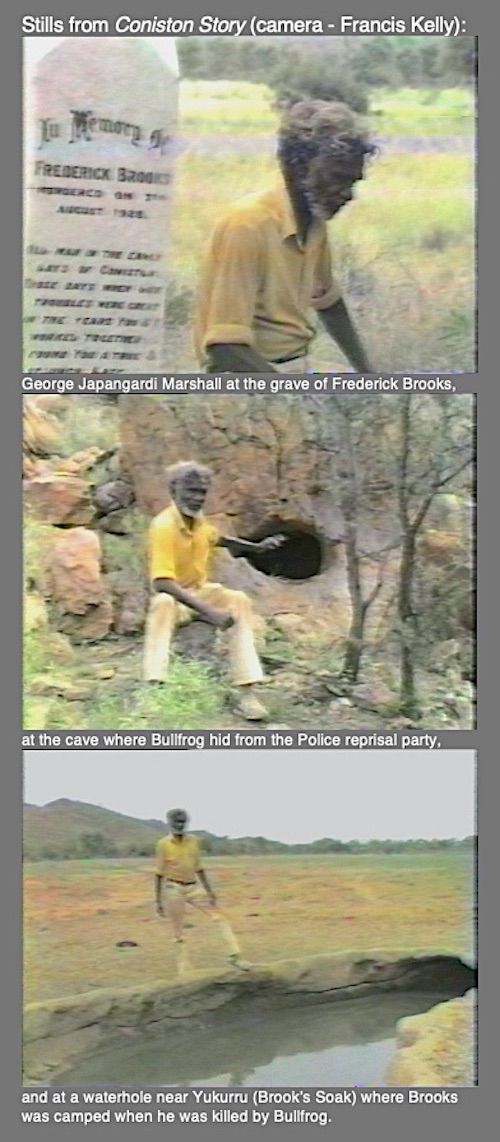
In a number of published works, Michaels traced the expressions of Warlpiri social relations through the production process. A video entitled the ‘Coniston Story’ was reportedly the first video produced specifically ‘for the camera’ (Michaels 1989: 42). In describing the wider context in which this oral history video was recorded, Michaels introduced his readers to some of the primary underpinnings of Warlpiri sociality. So that, for example, on the day the filming was to take place, Michaels was somewhat bemused to find that more than twenty people, travelling in several cars, accompanied the appointed video worker, storyteller and himself out to Coniston where the filming was to take place. Only later did he learn that what at first appeared to him as a curious yet arbitrary assembly of people was actually a core group of owners and managers of the country to be visited. This was, Michaels observed, no
… afternoon picnic with a casually assembled assortment of available kinship riders. In fact, each of the people accompanying us was directly accountable, in terms of Aboriginal reckoning, for some aspect of the story we were telling. The video could not be made without their presence (Michaels and Kelly 1984: 30).
The storyteller for the Coniston Story was one old Japangardi, son of legendary ‘Bullfrog’, one of two Warlpiri men who claimed responsibility for the death in 1928 of a dingo trapper Fred Brooks. Brooks’ murder was the trigger for punitive raids through Anmatyerre and Warlpiri country in 1928–9 in which dozens of Aboriginal people were killed, a terrifying time in Aboriginal memory that has come to be known as the Coniston massacres.
Michaels observed that while in European terms Japangardi could speak of these events in his own right, in Warlpiri reckoning his telling required the presence of certain specific kin to authorise the performance as junga, proper or true (Michaels and Kelly 1984: 30). Japangardi has rights to the story as the descendent of one of its key protagonists, but also as kirda, owner of the Dreaming and country in which these events occurred. Relevant kurdungurlu, managers, must be present to witness that Japangardi tells his story ‘proper way’. Michaels observed in the filming of this video that in line with the ritual relationship between owners and managers, only kirda appeared in front of the camera, on centre stage as it were. Kurdungurlu stayed ‘on the side’, witnessing and directing (Michaels and Kelly 1984: 32).
Elsewhere, Michaels discusses the particular kinds of challenges that audio-video recording practices pose for people such as the Warlpiri who carefully regulate the exchange of knowledge within kin groups as well as across generation and gender. The revelation of ritual knowledge, for example, traditionally occurred in contexts grounded in space and time, with strict control over who could/could not see and/or hear what was being revealed. Michaels points out that recording these events in audio-visual format dissolves such constraints, enabling knowledge to be lifted out of the space and time and social context in which it was originally exchanged (Michaels 1985). In seeking to highlight Warlpiri people’s distinctive experience of new media, Michaels provides examples of what he sees as the clashing of two cultural systems diametrically opposed in their logics:
The bias of mass broadcasting is concentration and unification; the bias of Aboriginal culture is diversity and autonomy. Electronic media are everywhere; Aboriginal culture is local and land-based (Michaels 1989: 13).
People familiar with Michaels’ work will recall that his interest in Warlpiri media activity was by no means merely anthropological. Michaels was an advocate of community broadcasting, and saw particular possibilities arising from Warlpiri people’s engagement with new media. One aspect of his work centred on predicting what the ‘risks’ associated with bringing television to remote townships such as Yuendumu might be. In his most well-known work, For A Cultural Future, Michaels spells out the implications of Warlpiri people failing to realise control over mass media. Around this question of control, he articulates two alternative possible futures for the Warpiri; a choice between cultural maintenance and what he dubs as ‘a cultural future’, or a ‘lifestyle future’ and cultural demise. In Michaels’ analysis this ‘lifestylism’ looms as a threat wherever bureaucracy attempts to undermine local Aboriginal control. ‘In a practical sense’, Michaels writes:
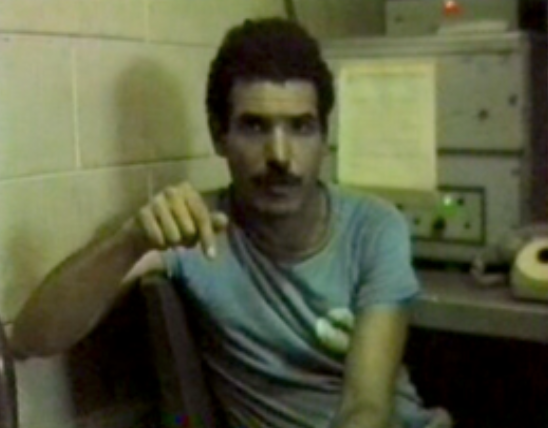
Eric Michaels in The Aboriginal Invention of Television, 1986
I want to subvert the bureaucratisation of [Aboriginal media], such as may be expressed in the training programs, funding guidelines, or development projects which claim to advance Aborigines, but always impose standards alien to the art (because these will be alien to the culture producing it). Wherever Australian officialdom appropriates a population, as it has attempted to do with Aborigines, it quickly bureaucratises such relationships in the name of social welfare. This assuredly defeats the emergence of these sovereign forms of expression, as it would defeat Jupurrurla’s own avowed objective to create Yapa—that is, truly Warlpiri—media (Michaels, 1989: 25).
By ‘cultural future’, Michaels means:
… an agenda for cultural maintenance which not only assumes some privileged authority for traditional modes of cultural production, but argues also that the political survival of indigenous people is dependent upon their capacity to continue reproducing these forms (1989: 73).
‘A cultural future’, he argues, ‘can only result from political resistance’ (Michaels 1989: 78).
Here, I want to hone in on Michaels’ unproblematised deployment of the concepts of ‘cultural maintenance’ and ‘traditional modes of cultural production’. In his terms, a ‘cultural future’ will only be realised if the Warlpiri can ‘embed [video] production in traditional forms’ (Michaels & Kelly 1984: 34). There is a false dichotomy implicit in this statement—between traditional and modern, culture and lifestyle and, indeed, local and global—that assumes cultural reproduction to be a static process. In Michaels’ accounts ‘culture’ is reified as a set of aesthetic practices or ‘systems’ to be preserved, rather than comprehended in its richer more anthropological sense of practices and meanings enacted in social relations evolving through time. It is in the deployment of this rigid and reified notion of ‘culture’ that Michaels’ model of Warlpiri media practice runs into trouble. For there is a further unintended consequence here: in adopting a discourse of ‘cultural maintenance’ Michaels allows Warlpiri people only one way of engaging with new media that is considered truly authentic. In so doing he falls prey to what Robert Hodge (1990) has dubbed the ‘spirit of Aboriginalism’. In this ‘cultural future’ Warlpiri people will manage to do what no other people have done before them: they will succeed in subverting the very logic of the mass media and globalisation. Here lies the possibility of enhanced Warlpiri autonomy, and the protection of their ‘sovereign forms of expression’ (Michaels 1989: 25). Yet if they fail, they will be subsumed within the homogenising tendencies of those same media, lose their cultural distinctiveness, and become but one manifestation of a pan-Aboriginal mass. Michaels’ argument is clearly anti-globalisation; for him the continuing resilience of Warlpiri cultural identity is dependent upon Warlpiri people’s ability to hold what he sees as the homogenising tendencies of globalisation at bay. Yet he fails to comprehend the contradiction implicit in his model: the very social form which is identified as posing an unprecedented threat to Warlpiri cultural life—technological mediation, in this case incorporating video and television—is simultaneously held up as offering the key to their potential salvation.
At this point it is worth pausing to consider the context in which Michaels was developing this argument. I stated at the outset that part of my interest in revisiting his work is to explore the extent to which Michaels’ accounts of Warlpiri media practice resonate with debates about the nature of globalisation that were emergent at the time he was writing. In fact, it was not until the end of the 1980s that globalisation became an explicitly articulated focus of study for cultural theorists. The end of the ‘80s was momentous in world politics—the collapse of communism in the USSR and Eastern Europe, the fall of the Berlin Wall, the students’ uprising in Tiananmen Square, all signalled the end of the Cold War and the emergence of a ‘new world order’. Inextricably bound up with these developments was the acceleration of global capitalism, brought forth by a symbiosis of the market and a massively expanded electronic media (Jameson 1992: 275, Hinkson, J. 1993). These events in turn resonated throughout the academy and were mirrored by a considerable shake-up of critical thinking which had been emergent over four decades. The end of the 1980s saw a proliferation of writing concerned with transcending binary frameworks and exploring new approaches to understanding the cultural implications of globalisation (see for example Featherstone 1990; Jameson 1992; Marcus & Fischer 1986; Tomlinson 1990). Early approaches tended to be framed within the binary distinctions of the previous era: globalisation was viewed as either equal to homogenisation or diversification; one was either ‘for’ or ‘against’ globalisation. More recently, binary frameworks of thinking have to a certain extent been displaced by concerns to explore what is occurring on the local side of the global-local nexus [5]. Anthropologists and cultural theorists have sought to understand the different ways in which the complex processes of globalisation penetrate local communities and become embedded in local social relations, practices, and meanings (see for example Appadurai 1995; Fardon 1995; Clifford and Marcus 1986; Friedman 1990).
Michael’s work on Warlpiri media practice can be located at the early end of this emergent body of writing. The oppositional framework of his analysis—his prediction that the technological mediation of the Warlpiri life world would result either in a ‘cultural future’ or a ‘lifestyle future’ (Michaels 1989)—is to some extent reflective of the politics and sensibilities of that period. Michaels’ stance clearly reflects a binary vision of politics [6].
There are other, less abstract, angles from which to critically engage with Michaels’ static oppositions. As I discuss later in this article, such oppositions fail to reflect a long and complex history of inter-cultural engagement at Yuendumu that well and truly pre-dates the arrival of television (and indeed the end of the Cold War). Yet perhaps the most compelling counterargument to Michaels is simply reflected in the subsequent use of communications technologies that occurred at Yuendumu after his departure.
In his final report to the Institute, published as The Aboriginal Invention of Television: Central Australia 1982–86, Michaels (1986: 29–30) reported that the modes of communication available to Yuendumu residents for contact with the outside world were:
a highly unreliable radio-telephone
a telegram service
Royal Flying Doctor Service emergency radio
Police radio frequency
A CB radio network (operating in European houses)
a twice weekly mail service.
Less than a decade later this situation had shifted considerably. In 1995, when I arrived at Yuendumu to undertake research with Tanami Network, there was:
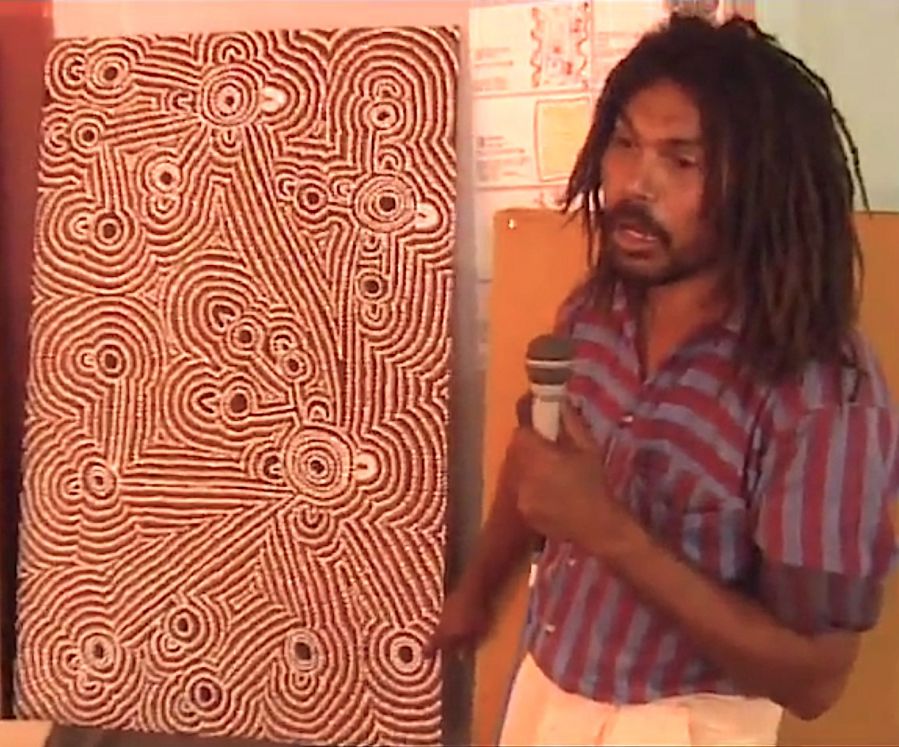
Francis Jupurrurla Kelly explains the Tanami Network, in Satellite Dreaming
a functioning telephone system (supporting phones and fax machines in the offices of all community organisations, phones in most European homes, and five public phone boxes three of which were available after business hours)\
two television channels (ABC and Imparja) transmitted simultaneously, with ‘interruptibility capability’ for insertion of other programming
two radio stations, ABC and Imparja, again, with ‘interruptibility capability’
email and internet access (utilised at this stage by three community organisations and the school)
a video conferencing network (Tanami Network, co-owned with the communities of Lajamanu, Willowra and Kintore and linked to sites in Alice Springs and Darwin) (Hinkson 1999, chapters 4 & 5).
By June 2001 Yuendumu’s connectedness to the ‘outside’ world had expanded even further—there were now four television channels being transmitted simultaneously, access to telephones had increased subsequently, with phones recently installed in 14 new Warlpiri houses, and Eftpos facilities were now available in the Social Club store.
This potted history of technological evolution at Yuendumu deserves considerable unpacking, but it is not my intention to do so here. I list these developments in shorthand merely to spell out the extent to which ‘remote’ townships such as Yuendumu have been caught up in the telecommunications revolution which has swept the world in the past two decades. 15 years ago, Michaels saw the introduction of commercial television looming as an unprecedented challenge to remote living Aborigines. With the benefit of hindsight, the arrival of television comes to be seen as just one manifestation of a much broader process: globalisation, in a new accelerated and technologically extended form (Sharp 1993), carried to all corners of the world [7].
New communications technologies have greatly expanded Warlpiri people’s engagement with images, objects, people and places that originate from outside their township. Conversely, they have made Yuendumu ever more accessible to a whole array of institutions with diverse interests in that place. But how has this high-tech revolution manifest itself on the ground at Yuendumu? To invoke the work of Jonathan Friedman (1990), how has globalisation been localised? What other changes in Warlpiri social life has it coincided with?
By late 1987 Yuendumu was receiving and retransmitting ABC and Imparja TV simultaneously, as well as ABC and CAAMA radio. The government issued BRACS [8] equipment through which television and radio programs were being transmitted to monitors within the township had an interruptibility capacity built into it—the incoming signal could be turned off as required and replaced with alternative programming. This was a technical response to representations made to the Australian Broadcasting Tribunal hearings in 1984 by remote living Aboriginal people and their supporters, including Michaels, who were calling for some form of effective local control over the images that appeared on local television monitors. Over subsequent years, this interruptibility capacity has been used with varying frequency at Yuendumu.
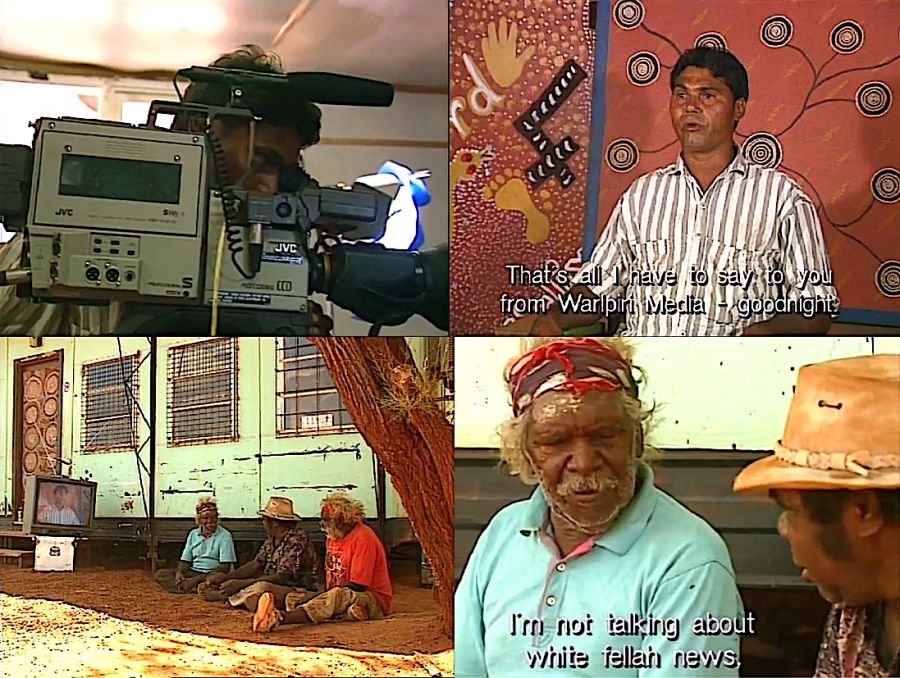
Francis Jupurrurla Kelly records and transmits Warlpiri News (stills from Satellite Dreaming 1991)
From Michaels’ time to the early 1990s, a locally produced Warlpiri news program was broadcast with varying regularity, and from time-to-time other programming was transmitted. The really concentrated focus on television broadcasting came to an end after Francis Jupurrurla Kelly, who had worked so closely with Michaels, resigned from Warlpiri Media in 1991. The changing activity of the media association over time has reflected a changing personnel and skills base. For a significant part of the period between 1992 and 1996, for example, Warlpiri Media was represented by one Warlpiri woman, Valerie Napaljarri Martin, who received support from a series of white advisers who turned over in rapid succession. During this period there was greater emphasis on radio broadcasting, with lesser attention given to video production and television broadcasting.
Recall Michaels’ stated aspiration to ‘subvert the bureacratisation of Aboriginal media’ (1989: 25)? After his departure from Yuendumu such resistance was considerably difficult, as the resources accompanying Michaels’ research fellowship were no longer available to the project. Alternative funding had to be found and before long, Warlpiri Media was operating more or less within the constraints of federal government funding provisions. These constraints presented a particular bind for Warlpiri Media. By 1994 the organisation could only access money to fund a coordinator’s position if that position was expanded to include the provision of training to eight other media associations of the region. The delivery of this training program in turn, while appreciated by neighbouring media associations, meant that little time could be dedicated to supporting activity at Yuendumu. Indeed, for a good part of the early 1990s the Warlpiri Media coordinator was based in Alice Springs for logistical reasons, visiting Yuendumu on a fortnightly basis.

Bush Mechanics title card
In late 1996 these circumstances changed. The arrival of a highly skilled and entrepreneurial coordinator [9] saw Warlpiri Media’s organisational base begin to expand. A number of collaborative projects undertaken with professional film makers were launched; Munga Wardingki Patu—Night Patrol, Marluku Wirlinyu—the Kangaroo Hunters, Bush Mechanics. Successful applications for grant monies to fund these projects brought much needed resources into the organisation which could in turn be used to support other activities. A video trainer was employed. By June 2001 the organisation employed three non-Aboriginal people—a manager, video trainer, and radio trainer—as well one Warlpiri man, a multi-talented digital artist, musician, sound recordist, website designer, and computer technician. Six male and one female CDEP [10] scheme participants were also working for the organisation in a range of capacities, most particularly, in radio broadcasting. In recent months Warlpiri Media had taken up a weekly three-hour spot on CAAMA radio, and there appeared to be a great deal of enthusiasm for participating in this work. A locally produced CD profiling bands of the region was in the process of being mixed down. A four-part series of Bush Mechanics was in final edit.
In skimming briefly across the history of the Warlpiri Media Association it is possible to identify a particular dynamic at work; a gradual expansion of the organisation’s operations, and a gradual shift in direction to activities that are not necessarily or unambiguously local in focus [11]. It is this dynamic which underwrote a subsequent major development at Yuendumu, the establishment of the Tanami Network.
The earlier activity of the Warlpiri Media Association laid the groundwork for the establishment in 1991 of Tanami Network, the first publicly accessible and Aboriginal owned video conferencing network in the Northern Territory. Tanami Network was launched after representatives of Yuendumu, Lajamanu, Willowra and Walungurru (Kintore) voted to contribute significant moneys from local mining royalties to this cause [12]. Like the earlier media experiments, this project was conceptualised at the intercultural interface. The establishment of the network was proposed to Aboriginal people of the region by the working partnership of Peter Toyne and Robin Japanangka Granites. It is notable that at this stage, Toyne, who had been an adult educator and principal of the Yuendumu school [13], had lived at Yuendumu for more than a decade. He was also integrally involved in the early video production training programs and the establishment of the Warlpiri Media Association.
At the time Aboriginal representatives of the four townships voted in favour of launching their own video conferencing network, they also identified a number of programs they were keen for the facility to provide. Paramount among these were a secondary education program, which for the first time would allow children of the member communities to participate in secondary classes without leaving home; a prison links program linking the member communities with the Alice Springs and Darwin prisons; and links between the four member communities who share close familial and ritual ties. Providing a detailed account of Tanami Network is beyond the scope of the current paper (see Hinkson 1999), but the uses to which the facility was put in the first four years of its operation provides something of an overview.
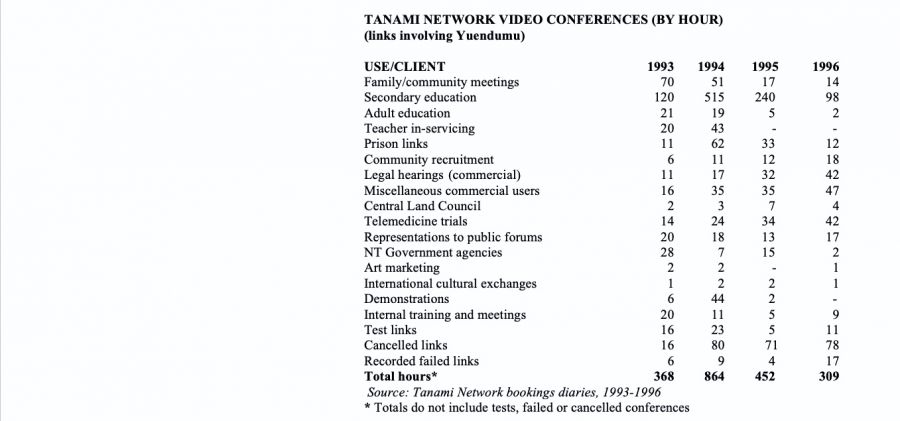
It is possible to analyse the social relations of particular video conferences and produce similar descriptions to those which appear in Michaels’ accounts of video production. There is no shortage of evidence to support the argument that Warlpiri people relate in a culturally distinctive fashion via electronic media. Interestingly enough, in my experience they also tend to be more competent users and more at ease with the medium than Europeans. Warlpiri people cope better with time delays, often drawing on other means of communication from their cultural repertoire, such as sign language, to help facilitate dialogue between large groups of people mediated by video link. I also witnessed many instances of Warlpiri people using video links for purposes other than, or complementary to, that which had been planned.
One such series of links was held between Yuendumu and the Art Gallery of New South Wales over a period of four days in August 1997. Four senior Warlpiri men had been commissioned to produce a sand painting in the gallery for the Festival of the Dreaming. An ISDN video link was installed to enable people at Yuendumu to watch the progress of the painting over the three days it took to complete, and to participate in its launch. At the outset, the artists viewed the link as important because it would facilitate the ‘witnessing’ and endorsement of their cultural production by others, including the most senior kurdungurlu (manager) of the Dreaming being depicted, who was too old and unwell to travel. It also allowed children to be involved in the process, through class visits to the video conferencing suite on a daily basis to observe the painting being made.
The day after the artist’s departure for Sydney a senior Warlpiri man died in Alice Springs Hospital. He had been ill for some time, but his death was unexpected. The artists were greatly distressed on hearing the news and expressed a desire to cancel their commitments to the gallery and return home immediately. Yet, after extensive consultation with other senior men at Yuendumu via video conference, who encouraged the artists to stay in Sydney and complete the ground painting, the men decided to stay. The link was used extensively each day to keep the artists in Sydney informed of the progress of ‘sorry business’, to inform them which kin had arrived at Yuendumu to participate, and to reassure the artists that these ceremonies would not ‘finish up’ until they had returned.
For those attending the launch of gallery’s program for the Festival of the Dreaming, the exchanges occurring between Warlpiri people via the video conference link would no doubt have been interesting to observe. It would have been clear that the video link enabled people at Yuendumu to participate in the launch. The link would have also provided them with a wider context, and perhaps indeed an authentic grounding point, for their appreciation of the artwork. Yet, from a Warlpiri perspective, the link had a different value altogether. At Yuendumu, and behind the camera as it were, there was a flurry of activity on the day of the launch. A large number of kin had arrived from nearby Papunya and Mt Allen the previous night to participate in the funerary rites. Under instruction from a senior female manager, I was enlisted to transport key groups of kin from ‘sorry’ camps to the video conferencing suite and back again, so that they could report to and take advice from the men in Sydney, on various aspects of ceremonial organisation. Here, it seemed to me, were two quite distinct events occurring simultaneously.
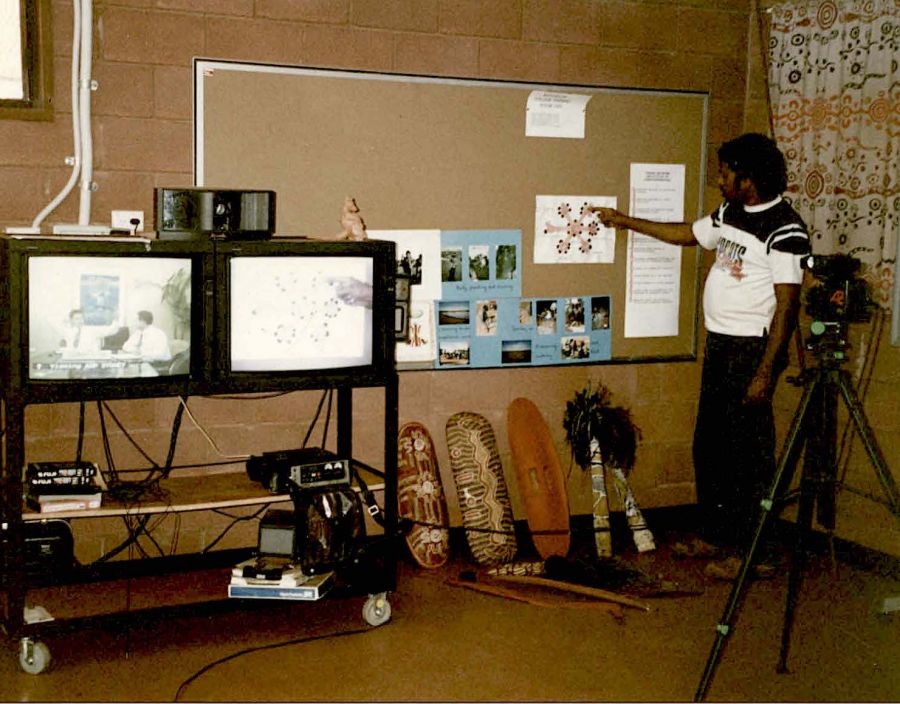
Tanami Network Video confererence, PAW Media building, Yuendumu, 1980s/90s (© PAW Media)
Now a question often asked in relation to Tanami Network is why would people who are so ‘disadvantaged’ according to what we might refer to as ‘mainstream social indicators’ want a video conferencing network? Indeed, a criticism commonly levelled at those associated with the network’s establishment is that the amount of money involved—$1.6M infrastructure and substantial recurrent costs—could have been allocated to other, more basic priorities. From one perspective, taking the health, housing, and education circumstances of many Warlpiri families into account, surely, they are right. Yet, if we conjure up the diverse social arenas in which contemporary Warlpiri life is lived, this question of priority is recast in complex and important ways. The above example gives the beginnings of a sense of this—increasingly Warlpiri identity is enacted in diverse contexts that are geographically and culturally distant from Warlpiri country and Yuendumu. Over the past two decades a new kind of mobility—interstate and overseas travel—has become commonplace, most directly as a result of the growing national and international interest in Warlpiri art. As Warlpiri people travel further away from home, they and their kin require new social mechanisms through which to maintain communication with each other. Such linkages are highly valued because of the premium Warlpiri people place on maintaining and reproducing social relationships through intensive interaction. Mechanisms such as video conferencing enable such communication to take place in a new technologically extended (Sharp 1993) form. Because video conferencing is a visual medium, it also enables the kin who stay at home to witness some aspects of the traveller’s experience.
The range of uses to which Tanami Network was put over the first four years of operation provides a wider context for considering such issues. In surveying such uses (see table above) it becomes clear that describing Warlpiri people’s use of video conferencing in terms of ‘cultural maintenance’ is misleading. Certainly, there are categories of links that could be seen as simply extending the context in which relations between kin are fostered and reproduced—particularly the categories of family/community meetings and prison links. But as the data in the table reflects, these are by no means the dominant uses [14]. When Warlpiri people participate in video conferencing—whether it be in school classes, in exchanges with other indigenous peoples, in meetings with government departments or service providers, or in exhibitions of Warlpiri art—they may be engaging in many things, but I would argue that ‘cultural maintenance’ is low order among them. It seems to me that there is a different cultural dynamic at work here. This is a tendency in Warlpiri society to go forth, as it were, to reach outwards, to engage with people, objects, images, and ideas, across the inter-cultural divide, at the same time as seeking new ways to maintain connections with the kin who now travel through this expanding social arena.
To locate these developments explicitly within current debates about globalisation: it is clear that Warlpiri people’s engagement with the wider world via new media such as video conferencing is a two-way process. As the potential points of articulation between the local and the global increase, it follows that Warlpiri people, like the rest of us, require new mechanisms with which to grapple with these new circumstances. From one perspective modes of communication such as video conferencing can be seen as sustaining locally grounded Warlpiri social life: one of the most significant features of Tanami Network is that it enables Warlpiri people to participate in a whole range of forums without leaving home. But this is not to say that in doing so they ‘resist’ globalisation, on the contrary. There is a contradiction embedded in this process. At the same time as new media provide the Warlpiri with new mechanisms for dealing with contemporary circumstances, those same media also sustain those circumstances. Globalisation has become embedded in Warlpiri social relations in complex ways, meaning at base that Warlpiri identity is no longer simply enacted through the highly localised social formations which have long been associated with Aboriginal societies, but also, and increasingly, through more abstract, technological modes of exchange. As a consequence and as I discuss below, Warlpiri people face new challenges and choices regarding how they might hold together the different orders of social relatedness that circumscribe their world.
The Warlpiri Media Association portrayed in Michaels’ accounts was represented as an almost entirely Warlpiri affair. For evidence of this we need go no further than the titles of his published works: For A Cultural Future: Francis Jupurrurla Makes TV at Yuendumu, and The Aboriginal Invention of Television.
A number of Warlpiri participants in the media project were identified and given prominence in Michaels’ accounts. Yet Michaels revealed little of the role he himself played in shaping the early period of Yuendumu’s engagement with new media, and even less of another key participant, Peter Toyne. With few exceptions [15], where non-Aboriginal involvement in the media project is discussed, such individuals are more often depicted as simply facilitating Warlpiri aspirations. At one point Michaels suggests that the media project has successfully captured Warlpiri enthusiasm because it entailed ‘minimal European intervention’ (1990b: 25). As Toyne reflected in discussion with me a decade later:
[Michaels’] whole model was one of Warlpiri adoption of broadcasting and media. It had no sense of a partnership or meeting of traditions. It was basically, kind of like [the Warlpiri] taking on technology and production processes and turning them into Warlpiri things. [Michaels] didn’t ever theorise the relationship that was occurring. And in fact, I had a raging argument with him when he showed me the draft of the Aboriginal Invention of Television because I felt that the whole of reality had disappeared. I mean the whole actual process that had brought the community together and had seen broadcasting happening and all the production … It wasn’t a personal hurt so much as the dishonesty of the model. It simply didn’t describe what we were going through. It was just mythology.
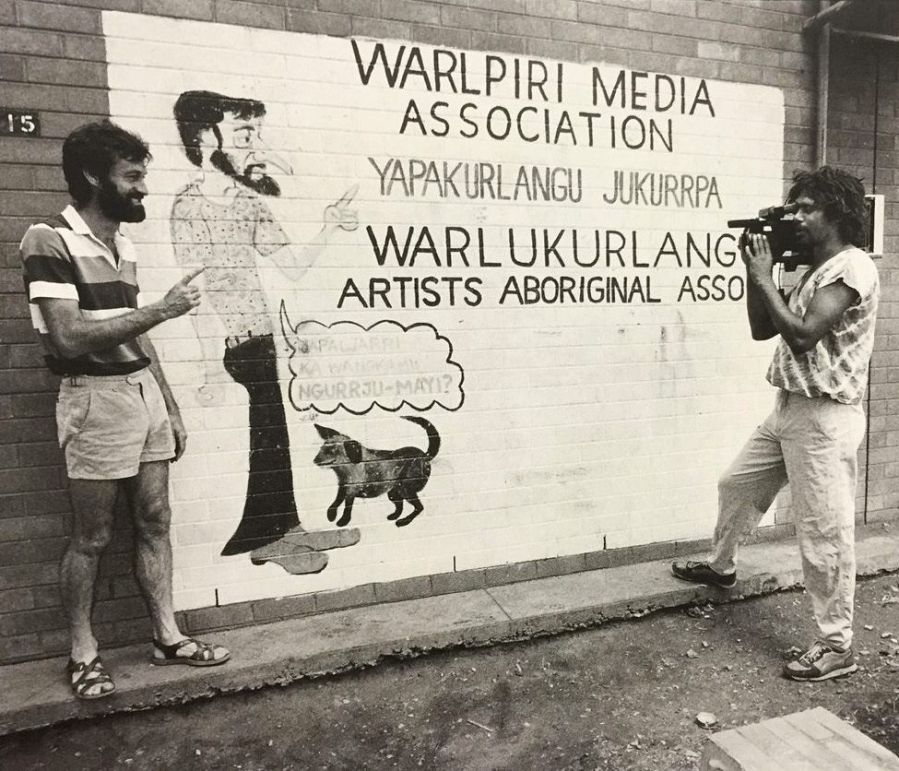
Peter Toyne and Francis Jupurrurla Kelly, outside the WMA studio, 1987. (Photo: Jon Rhodes/PAW Media)
At the most basic level, the accuracy of Toyne’s critique is reflected in the very first television broadcasts that were made at Yuendumu in August 1985. VHS recordings of these broadcasts are held in Warlpiri Media’s video archive. In viewing these tapes, one observes a group of young Warlpiri men in the broadcasting room, with a non-Warlpiri voice audible in the background, recognisably that of Peter Toyne, discussing technical problems with the planned transmission. Conversation between the young men is in Warlpiri, with much joking. When Toyne advises the men that the transmission link has been secured and they are ‘on air’, two Warlpiri men seated side by side in front of the camera compose themselves and start talking to each other in English. Their discussion takes a question-answer format, decidedly un-Warlpiri in its manner. One asks the other, ‘what is your name?’, ‘where do you live?’, ‘what do you work?’.
Now, it seems striking that such a prolific writer as Michaels, particularly with his interest in the social relations of Warlpiri video production, chose never to write about the social relations of this first broadcast. The conclusion I draw from this episode is that, at the outset, the Warlpiri participants in the Yuendumu video and television project seem to have had their own, very particular assumptions about who their viewing audience was. Surely it was not Warlpiri people they were imagining watching their exchange on television monitors? Alternatively, perhaps it was, and these men were familiar enough with mainstream television formats to be engaging in mimicry. Regardless, it would seem that in this early phase, something more complex was occurring than the ‘Warlpiri TV for Warlpiri people in the Warlpiri language’ that Michaels documents.
My aim in drawing attention to these first broadcasts is not to expose Michaels’ depictions of Warlpiri media activity as myth. What I do want to do however is give some focus to a core aspect of the Yuendumu media experiments which remains largely invisible in Michaels’ accounts, namely, their inter-cultural nature—inter-cultural in terms of participation, inter-cultural in terms of the traditions being engaged, inter-cultural in terms of the meanings produced. It follows that there are two important questions to be addressed: firstly, why did Michaels’ fail to capture the inter-cultural nature of the media project? And secondly, why does it matter?
Other commentators have pointed out that Michaels allowed his politics to set limits to his analysis (Rowse 1990: 178; O’Regan 1990). Such an observation explains the many unresolved contradictions in Michaels’ work; his oscillation between radically different theoretical positions, and indeed his failure to develop a coherent theory of communicative forms (see Hinkson 1999; O’Regan 1990). His was a politics based largely around black power concepts imported from the United States, incorporated into the rhetoric of Aboriginal self-determination. In fairness to Michaels, it is important to recognise the historical context in which he was writing. The broad international and theoretical dimensions of this context were outlined briefly above. In relation to Australia, the mid–1980s were a period of considerable optimism for Aboriginal people and their supporters. Land Rights legislation had been passed for the Northern Territory in the previous decade, and the newly implemented federal government policy approach of self-determination was in the process of being bedded down. A new Labour government had been elected in 1983 and there was hope that some of the progressive policy making of the early 1970s might be revisited. The rhetoric of self-determination was highly charged. This rhetoric put the control of Aboriginal futures unambiguously in Aboriginal hands. There was an associated tendency in much writing of the era to overlook or play down the participation of the non-Aboriginal advisors, coordinators, and managers who replaced the superintendents in the domain of community development [16]. Sympathetic whites were viewed as playing a transitional role in a newly emergent regime. It was assumed that they would eventually make themselves redundant, with a new generation of Aboriginal leaders stepping into the breach. In line with such thinking, Michaels and Kelly (1984: 34) argued in 1984 that Aborigines should ‘be acknowledged as the experts in the matter [of video production] and that training, production and distribution assistance by Europeans be reduced to an ancillary role’.
To put it quite simply, to date, history has proved them wrong. As the use of new media at Yuendumu has expanded to encompass new formats and more complex projects, the number of non-Warlpiri people involved in those projects has increased as well. There is no sign of this situation changing in the short to medium term. In the context of the discourse of self-determination that Michaels and many others have sought to frame their discussions of Aboriginal media, how are we to understand this?
In the last decade and a half, anthropologists and other commentators have brought some of the complex implications of self-determination to public attention. It is now widely recognised that the policymakers who bequeathed responsibility for community governance and its associated institutions to Aboriginal people in remote locations were blind to the fact that the very notion of ‘community’ at the heart of their program was of a culturally pre-determined form with no precedent in Aboriginal society (see inter alia Folds 2001, Martin 1995; Merlan 1998; Myers 1985; Rowse 1995; Sullivan 1996a). More recently, debates around the shortcomings of self-determination have entered a new phase. Commentators of both the left and right, as well as Aboriginal people themselves, are urging government to recognise that a social crisis exists in many parts of Aboriginal Australia, a crisis that demands a major policy re-think (see Pearson 2000; Sandall 2000; Sutton 2001).
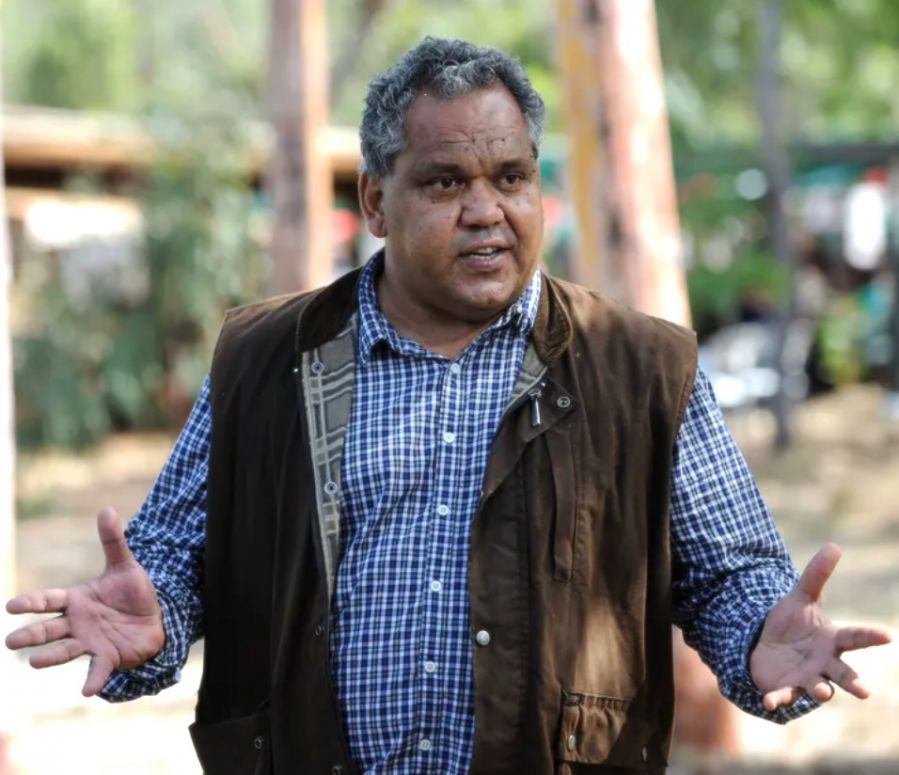
Noel Pearson (AAP)
As the only high-profile Aboriginal leader to have comprehensively entered this fray Noel Pearson’s interventions have attracted a great deal of attention. Pearson is calling for a new form of self-determination in which the interactions between Aboriginal communities and government are brought into a new alignment. His model focuses particularly on the need for cultural redevelopment to take place within Aboriginal communities. At the centre of Pearson’s vision is the call for a new pact of responsibility and reciprocity between individual Aboriginal men and women and their families and communities, and in turn between those communities and the wider Australian society. Pearson calls for the establishment of new indigenous governance institutions that might provide a centralised interface between indigenous communities and government and other service providers. Pearson’s is a bold and extremely important intervention into the self-determination debate. But as Martin (2001) has argued, his model of self-determination requires of Aboriginal people a form of individual responsibility that has no precedent in Aboriginal society, raising the prospect that the changes Pearson is calling for may in fact lie beyond the capacity of indigenous groups themselves to institute (Martin 2001: 18).
It is only in the unfolding of such debates, and indeed in recognising some of the cultural constraints on self-determination that a whole range of related issues might be addressed. An associated question that might be raised that allows us to place Michaels’ work in the context of these debates is, whose interests are served in the characterisation of community development as an unambiguously Aboriginal process? Like other community developments in remote Aboriginal townships, it is clear that Aboriginal media projects have not arisen spontaneously within an Aboriginal domain. It follows that there may be a whole host of reasons why Aboriginal people want non-Aboriginal people to continue being involved in their organisations.
Earlier I posed the question why does it matter that Michaels failed to identify the inter-cultural nature of the media projects he was involved in? This is a question that deserves to be addressed on a number of levels. At the most localised and practical level, developing a better understanding of how Aboriginal and non-Aboriginal people work together, and indeed don’t work together, is critical if organisations such as those under discussion here are to find a more stable base from which to operate. It is not uncommon for new non-Aboriginal employees to arrive at Yuendumu grasping their copy of Michaels’ The Aboriginal Invention of Television, or Bad Aboriginal Art, with particular preconceptions about the nature of the organisation they have come to work for and the role they will be expected to play. Enthusiasm often turns to bewilderment when reality does not match their expectations. Warlpiri people and non-Warlpiri people commonly have divergent understandings of the workplace and differing expectations of each other. It is not unusual for non-Warlpiri employees to leave Yuendumu disaffected and confused about what their time in the township has amounted to. New arrivals are given few handles for grappling with the complicated and evolving inter-cultural context they have come to work in. Fuelled by a well-entrenched discourse about the self-determining nature of Aboriginal community broadcasting, such a scenario becomes self-perpetuating.
Of course, the bemusement I speak of is not one-sided. Workplace relations have implications for the social lives of Warlpiri people outside the workplace, and it is not uncommon that they express frustration in relation to the constant turnover of staff, the difficulty of breaking in new staff, and to voice concerns about the difficulty of retaining corporate memory.
We have seen that Michaels viewed the coming of television as posing an unprecedented threat to the cultural integrity said to be enjoyed by Aboriginal people living in remote Australia in the early 1980s:
Video and television intrude in the processes of social and cultural reproduction in ways that literate (missionary, bureaucratic, educational) interventions never managed to accomplish. Its potential force is greater than guns, or grog… (Michaels 1989: 74).
But in making such a statement Michaels overlooked the existence of a whole generation of Warlpiri bi-culturalists, now middle-aged, who are more literate than many younger people of their children and grandchildren’s generations (see Hinkson 1999: 65–67). These biculturalists have been at the forefront of community development projects, including the establishment of the media association and Tanami Network. Michaels’ depiction of processes of cultural reproduction remaining ‘intact’, fails to capture the evolving nature of Warlpiri sociality as people turn their attention to new areas of activity and opportunity. In this regard Michaels’ work is a clear example of what Francesca Merlan (1998: 232) has called ‘ethnographic primitivism’ [17]. More generally, he simply does not take account of a long history of inter-cultural interaction at Yuendumu. This history can be traced across more than fifty years of increasing entanglement of Warlpiri social life with non-Warlpiri people, objects, images, and frameworks of meaning. If we take this history into account, new media come to be seen as but the latest, albeit one of potential unprecedented magnitude, in a long line of innovations. The beginnings of this process, which, after Trigger (1986), we might conceivably describe as the beginning of the end of domain separation, can be traced back to the earliest days of contact. Over time, it has been reflected in the physical movement of Warlpiri people through space, as one middle-aged Warlpiri man, Neville Japangardi Poulson, recalls:
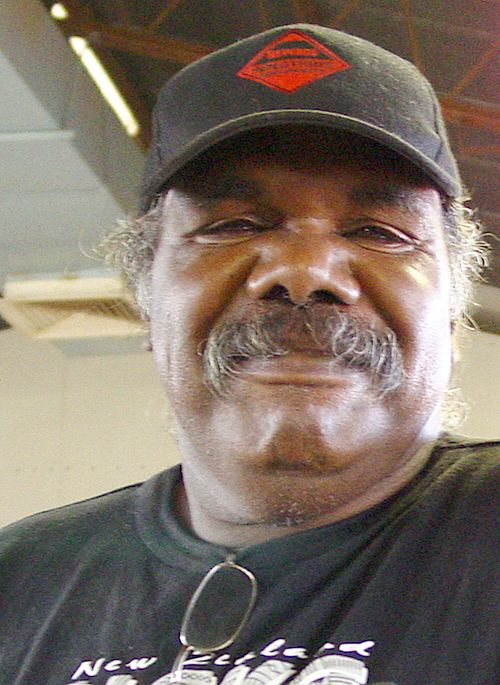
Neville Japangardi Poulson, 2004
(Photo © Warlukurlangu Artists)
[In the early days] yapa [Warlpiri people would] usually come in [to the settlement] for rations and go back to camps. And then round about maybe middle of the sixties, they started to come in. Two or three had houses, so, people could see, you know, ‘Oh good, [I’ll] make a humpy next to it. So, bit by bit, they’re starting to come in … And then in the seventies, more people coming. And then more yapa jobs, and training, night school, or go to Batchelor College. So more and more young people went to school … And they could see more and more lifestyles of kardiya [Europeans], to live … Like in Darwin, we used to [visit] going to place to place … And we learnt how to read, and read the street sign, so more and more we could be free…
This reflection, recorded in the context of a much longer conversation between Poulson and myself at Yuendumu in November 1995, gives an evocative description of the parameters of the Warlpiri world opening out once mobility accompanying new forms of work and education became available to Warlpiri people. This opening out is clearly a two-way process in which Warlpiri people are actively engaged, and facilitated by access to transport, increased mobility, improved communication with centres outside Yuendumu, as well as more accessible news of events occurring in the world at large via radio. Importantly, all of this predated the arrival of television.
It is important to note that researchers have made a constant presence throughout this history, dating back to times prior to Yuendumu’s establishment. More recently, in the era of self-determination, researchers have been at the forefront of helping facilitate many of the significant inter-cultural initiatives at Yuendumu, including not only the establishment of the media association, but also Warlukurlangu Aboriginal Artists Association, and the Tanami Network. Throughout the history of community development at Yuendumu, from well before Michaels’ time to the present, there have been many mutually enriching partnerships between Warlpiri and non-Warlpiri people that have driven such projects. It is through these relationships that the rhetoric of doing things ‘two ways’ has been fostered and given substance. Understanding how this wider context of inter-cultural engagement permeates the social relations of townships such as Yuendumu would seem to be critically important to the reformulation of self-determination as both a policy program and a political ideal. The proper representation of this inter-cultural context matters, because, as Francesca Merlan (1998: 170) has observed, at the most basic level ‘representations of Aborigines by others affect what they are allowed to be and become’.
The more than 1200 video tapes produced at Yuendumu over two decades that now form the contents of the Warlpiri Media video archive provide a window on these evolving circumstances. As documented by Michaels the archive contains audiovisual recordings made in the 1980s of public ceremonies, country visits, hunting and gathering expeditions, and sports events. But there are also recordings of community meetings at which Warlpiri people identify and attempt to deal with ‘problems’ such as petrol sniffing that have no precedent in pre-contact Warlpiri life. There are visits to the township by politicians and bureaucrats during which the crossed purposes of government and Warlpiri aspirations [18] are documented time and time again. There is the presentation to a senior Warlpiri woman of an Australia Day honours award, video conference links with Yuendumu artists and other indigenous peoples on the other side of the globe, and much more. These are some of the multifacted dimensions of social life at Yuendumu in an era of accelerated globalisation. The video archive constitutes an important historical record of two decades of social life in a unique and dynamic township where inter-cultural engagement has increasingly become a central part of what it is that Warlpiri people do.
The problem with a cultural maintenance approach to thinking about Warlpiri people’s interaction with new communications technologies is that it fails to reflect the very real changes in Warlpiri sociality that are occurring as the parameters of the Warlpiri lifeworld continue to expand. The developments discussed in this article make it clear that Warlpiri people are by no means passive observers of the transformations sweeping their world. Their ongoing engagement with new technologies suggests that at least some Warlpiri people see benefits in the new forms of articulation with the wider society that accelerated globalisation carries with it. For some there is a clearly understood political imperative to engage, for others, such engagement is comprehended as the product of a history that cannot be wound back. There is little question of ‘control’ in the way that Michaels articulated it.
Clearly, globalisation is not a one-way process; it requires active participation in order to become grounded in local contexts. As Hartley and McKee (2000) have observed for Aboriginal people’s interaction with the media on a national level, Warlpiri people have a sophisticated understanding of the politics of representation and actively seek to use those media, as well as other electronic modes of communication, to their own ends. That they do not always succeed goes without saying. At the beginning of the twentieth century, Warlpiri people face new challenges and choices regarding how they might live. Such challenges are not captured well by juxtapositions of ‘culture’ versus ‘lifestyle’. Fifty years after Yuendumu’s establishment, Warlpiri identity is being shaped, enacted, and asserted in a range of disjunctive yet overlapping social arenas. In these new circumstances many Warlpiri people see a greater range of choices than were previously available to them regarding how they might live. The choice to live in Alice Springs, to live interstate, to travel overseas and project aspects of Warlpiri identity on an international stage, to participate in film projects, research projects, and, indeed, the choice to stay at Yuendumu. All of these choices have implications for the community of people who identify as Warlpiri. New media and communications technologies increasingly sustain a new dimension of Warlpiri sociality. To what extent that dimension will be allowed to expand and overshadow more grounded ways of being is a question that the Warlpiri, like the rest of us, will have to address.
Footnotes
See Continuum 3 (2), 1990.
These figures are based on the 1996 Australian Bureau of Statistics census data.
The first Australian-owned satellite, which would bring national television to much of remote Australia for the first time.
Now the Australian Institute of Aboriginal and Torres Strait Islander Studies (AIATSIS).
This is not to ignore the anti-globalisation social movements that have been steadily on the rise internationally in recent years. However, in key respects these social movements are not anti-globalisation per se; by their very nature they are global movements, with the current model of corporate-defined globalisation supported by the World Economic Forum, the International Monetary Fund, and the World Bank, the target of their activism.
I thank an anonymous referee for bringing this important observation to my attention.
An anonymous referee pointed out that in this regard remote ‘outback’ Australia presents an unusual case in world terms. Looming large as it does in the Australian political imaginary, the ongoing effort to service ‘outback’ Australia occurs disproportionately to other countries with similar landmass.
BRACS is the Broadcasting for Remote Aboriginal Communities Scheme, introduced by the federal government in 1986 in response to the Willmott report (DAA 1984). For a wide ranging history of the policy framework in which Aboriginal broadcasting was ‘invented’ see Batty 2001. For a history of the implementation of BRACS see ATSIC 1998, Turner 1998.
The late Tom Kantor.
Community Development Employment Projects or ‘work for the dole’ scheme.
It is also interesting to note that the expansion of Warlpiri Media has not made any noticeable impact on the volume of media traffic in the shape of ‘outside crews’—film makers and news groups—that regularly appear at Yuendumu (see Hinkson 1995). Michaels wrote about some of the contradictions embedded in the interactions between the media association and visiting media agencies (see Michael 1987a).
The cost of establishing the Tanami Network infrastructure was $1.6M. The total amount comprised grants from the Janganpa Association ($300,000), Granites Mine Affected Areas Aboriginal Corporation ($599,000), ATSIC ($500,000) and the Aborigines Benefit Trust Account ($200,000) (see Hinkson 1999, chapter 5).
At the time this article was written, Toyne was Attorney General in the Northern Territory’s first Labour government, elected to power in 2001.
It is beyond the scope of this paper to discuss the reasons for the overall decline in use of video conferencing over the four year period that is reflected in the table. I shall do so in a subsequent article (see also Hinkson 1999, especially chapters 5 & 6).
Michaels’ does express the odd moment of disquiet, at one point worrying that Warlpiri Media might be judged as yet another ‘Aboriginal Advancement project some clever adviser inflicted on Aborigines, the discarded skeletons of which litter the remote countryside’ (Michaels, 1990: 24). Yet such moments are rare.
Notable exceptions include Gerritsen 1982; Sullivan 1996b; Merlan 1998.
Michaels’ suggestion that the Warlpiri have ‘skipped’ print literacy in favour of a form of electronic literacy fails to take account of the very real and pervasive impact that literacy practices have made on Warlpiri social life over the past five decades (see Hinkson 1999: 65-68). In seeing this ‘jump’ in terms of cultural continuity, Michaels (1985, 1987b) also reveals that he has no coherent theory of communicative forms (see also O’Regan 1990).
Ralph Folds (2001) has recently written incisively about the history of such engagements between Pintupi people and the State.
See Continuum 3 (2), 1990.
These figures are based on the 1996 Australian Bureau of Statistics census data.
The first Australian-owned satellite, which would bring national television to much of remote Australia for the first time.
Now the Australian Institute of Aboriginal and Torres Strait Islander Studies (AIATSIS).
This is not to ignore the anti-globalisation social movements that have been steadily on the rise internationally in recent years. However, in key respects these social movements are not anti-globalisation per se; by their very nature they are global movements, with the current model of corporate-defined globalisation supported by the World Economic Forum, the International Monetary Fund, and the World Bank, the target of their activism.
I thank an anonymous referee for bringing this important observation to my attention.
An anonymous referee pointed out that in this regard remote ‘outback’ Australia presents an unusual case in world terms. Looming large as it does in the Australian political imaginary, the ongoing effort to service ‘outback’ Australia occurs disproportionately to other countries with similar landmass.
BRACS is the Broadcasting for Remote Aboriginal Communities Scheme, introduced by the federal government in 1986 in response to the Willmott report (DAA 1984). For a wide ranging history of the policy framework in which Aboriginal broadcasting was ‘invented’ see Batty 2001. For a history of the implementation of BRACS see ATSIC 1998, Turner 1998.
The late Tom Kantor.
Community Development Employment Projects or ‘work for the dole’ scheme.
It is also interesting to note that the expansion of Warlpiri Media has not made any noticeable impact on the volume of media traffic in the shape of ‘outside crews’—film makers and news groups—that regularly appear at Yuendumu (see Hinkson 1995). Michaels wrote about some of the contradictions embedded in the interactions between the media association and visiting media agencies (see Michael 1987a).
The cost of establishing the Tanami Network infrastructure was $1.6M. The total amount comprised grants from the Janganpa Association ($300,000), Granites Mine Affected Areas Aboriginal Corporation ($599,000), ATSIC ($500,000) and the Aborigines Benefit Trust Account ($200,000) (see Hinkson 1999, chapter 5).
At the time this article was written, Toyne was Attorney General in the Northern Territory’s first Labour government, elected to power in 2001.
It is beyond the scope of this paper to discuss the reasons for the overall decline in use of video conferencing over the four year period that is reflected in the table. I shall do so in a subsequent article (see also Hinkson 1999, especially chapters 5 & 6).
Michaels’ does express the odd moment of disquiet, at one point worrying that Warlpiri Media might be judged as yet another ‘Aboriginal Advancement project some clever adviser inflicted on Aborigines, the discarded skeletons of which litter the remote countryside’ (Michaels, 1990: 24). Yet such moments are rare.
Notable exceptions include Gerritsen 1982; Sullivan 1996b; Merlan 1998.
Michaels’ suggestion that the Warlpiri have ‘skipped’ print literacy in favour of a form of electronic literacy fails to take account of the very real and pervasive impact that literacy practices have made on Warlpiri social life over the past five decades (see Hinkson 1999: 65-68). In seeing this ‘jump’ in terms of cultural continuity, Michaels (1985, 1987b) also reveals that he has no coherent theory of communicative forms (see also O’Regan 1990).
Ralph Folds (2001) has recently written incisively about the history of such engagements between Pintupi people and the State.
Appadurai, A. 1995. ‘The Production of Locality’, in Fardon, R. (ed.) Counterworks: Managing the Diversity of Knowledge, Routledge, London.
ATSIC, 1998. Digital Dreaming: A National Review of Indigenous Media and Communications, Canberra.
Batty, P. 2001. ‘Enlisting the Aboriginal subject: the state invention of Aboriginal broadcasting’, paper presented at the AIATSIS conference 2001, the ANU, 18-20 September 2001.
Clifford, J. & Marcus, G.E. (eds) 1986. Writing Culture: the Poetics and Politics of Ethnography, University of California Press, California.
Department of Aboriginal Affairs, 1984. Out of the Silent Land: Report of the Taskforce on Aboriginal and Islander Broadcasting and Communications, Australian Government Publishing Service, Canberra.
Fardon, R. (ed.) 1995. Counterworks: Managing the Diversity of Knowledge, Routledge, London.
Featherstone, M. (ed.) 1990. Global Culture: Nationalism, Globalization and Modernity, Sage, London.
Fischer, R. A. 1995. ‘Protohistoric Roots of the Network Self: On Wired Aborigines and the Emancipation from Alphabetic Imperialism’, unpublished manuscript, Zurich.
Folds, R. 2001. Crossed Purposes: The Pintupi and Australia’s Indigenous Policy, University of NSW Press, Sydney.
Friedman, Jonathan, 1990. ‘Being in the world: globalisation and localisation’, in Featherstone, M. (ed.) Global Culture: Nationalism, Globalisation and Modernity, Sage, London, pp. 311–328.
Gerritsen, R. 1982. ‘Blackfellas and whitefellas: the politics of service delivery to remote Aboriginal communities in the Katherine Region, in Loveday, P. (ed.) Service Delivery to Remote Communities, North Australia Research Unit, the Australian National University, Darwin.
Ginsburg, F. 1993. ‘Indigenous Media: Faustian contract or global village?’ in Marcus, G. E. (ed) Rereading Cultural Anthropology, Duke University Press, Durham, pp. 356–375.
Ginsburg, F. 1995. ‘Mediating culture: indigenous media, ethnographic film, and the production of identity’ in Deveraeaux, L. & Hillman, R. (eds) Fields of Vision: Essays in Film Studies, Visual Anthropology and Photography, University of California Press, Berkeley, pp. 256–291.
Hartley, J. & McKee, A. 2000. The Indigenous Public Sphere: The Reporting and Reception of Aboriginal Issues in the Australian Media, Oxford University Press, Oxford.
Hinkson, J. 1993. ‘Postmodern Economy: Self-Formation, Value and Intellectual Practice’, Arena Journal, new series, 1: 23–44.
Hinkson, M. 1996. ‘The circus comes to Yuendumu, again’, Arena Magazine, 25: 36–39.
Hinkson, M. 1999. ‘Warlpiri Connections: new technology, new enterprise and emergent social forms at Yuendumu’, unpublished PhD thesis, Department of Sociology, Anthropology and Politics, La Trobe University, Bundoora.
Hodge, R. 1990. ‘Aboriginal truth and white media: Eric Michaels meets the spirit of Aboriginalism’, Continuum, 3 (2): 201–225.
Jameson, F. 1992. Postmodernism, Or, the Cultural Logic of Late Capitalism, Verson, London.
Langton, M. 1993. ‘Well I heard it on the radio, and I saw it on the television…', Australian Film Commission, North Sydney.
Martin, D. 2001. ‘Is Welfare Dependency ‘welfare poison? An Assessment of Noel Pearson’s Proposals for Aboriginal Welfare Reform’, CAEPR Discussion Paper No. 213, Centre for Aboriginal Economic Policy Research, the ANU, Canberra.
Meadows, M. 1994. ‘Reclaiming a cultural identity: indigenous media production in Australian and Canada, Continuum, 8 (2): 270–292.
Meadows, M. 1996. ‘Making cultural connections: indigenous broadcasting in Australia and Canada, Australian-Canadian Studies, 14 (1): 103–117.
Merlan, F. 1998. Caging the Rainbow: Places, Politics, and Aborigines in a North Australian Town, University of Hawai‘i Press, Hawai‘i.
Michaels, E. 1985. ‘Constraints on knowledge in an economy of oral information’, Current Anthropology, 26 (4): 505–510.
Michaels, E. 1986. Aboriginal Invention of Television: Central Australia 1982-86, Institute Report Series, Australian Institute of Aboriginal Studies, Canberra.
Michaels, E. 1987a. ‘Hundreds shot in Aboriginal community: ABC makes TV documentary at Yuendumu’, Media Information Australia, 45: 8–17.
Michaels, E. 1987b. ‘Hollywood iconography: a Warlpiri reading’, in Drummond, P. & Patterson, R. (eds.) Television and Its Audience: International Research Perspectives, British Film Institute, London.
Michaels, E. 1989. For A Cultural Future: Francis Jupurrurla Makes TV at Yuendumu, Art & Text, Melbourne.
Michaels, E. 1990. ‘A model of teleported texts (with reference to Aboriginal television)’ Continuum, 3 (2): 8–31.
Michaels, E. 1994. Bad Aboriginal Art: Tradition, Media and Technological Horizons, Allen and Unwin, St Leonards.
Michaels, nd. ‘A proposal for terms of agreement/cooperation between the CAAMA and Eric Michaels, PhD, Visiting Research Fellow, regarding the Remote Television Project’, Eric Michaels papers, MS 2744, AIATSIS Library, Canberra.
Michaels, E. & Kelly, F. 1984. ‘The social organisation of an Aboriginal video workplace’ Australian Aboriginal Studies, 1: 26–34.
Molnar, H. 1990. ‘The broadcasting for remote Aboriginal community scheme: small vs big media’, Media Information Australia, 2 (2): 147–154.
Molnar, H. 1991. ‘Remote Aboriginal community broadcasting in Australia: developments and priorities, a paper for the AEJMC Conference in Boston, August 1991.
Myers, F. Pintupi Country, Pintupi Self: Sentiment, Place, and Politics among Western Desert Aborigines, University of California Press, California.
O’Regan, T. 1990. ‘TV as cultural technology: the work of Eric Michaels’, Continuum, 3 (2): 53–98.
Pearson, N. 2000. Our Right to Take Responsibility, Noel Pearson and Associates, Cairns.
Rowse, T. 1990. ‘Enlisting the Warlpiri’, Continuum, 3 (2): 174–200.
Sandall, R. 2001. The Culture Cult: Designer Tribalism and other Essays, Westview Press, Boulder, Colorado.
Sharp, G. 1993. ‘Extended Forms of the Social’, Arena Journal, new series, 1: 221–237.
Spurgeon, C. 1989. ‘Challenging technological determinism: Aborigines, AUSSAT and remote Australia’ in Wilson, H. (ed) Australian Communications and the Public Sphere: Essays in Memory of Bill Bonney, Macmillan Press, South Melbourne, pp. 27–45.
Sullivan, P. (ed.) 1996a. Shooting the Banker: Essays on ATSIC and Self-Determination, North Australia Research unit, the ANU, Darwin.
Sullivan, P. 1996b. All Free Man Now: Culture, Community and Politics in the Kimberley Region, north-western Australia, AIATSIS Report Series, AIATSIS, Canberra.
Sutton, P. 2001. ‘The Politics of Suffering: Indigenous Policy in Australia since the Seventies’, Anthropological Forum, 11 (2): 125–73.
Tafler, D. 1994. ‘Does the outback represent the centre? Tracing Electronic Tracks Across Australia, Continuum, 8 (1): 406–417.
Tomlinson, A. (ed.) 1990. Consumption, Identity and Style: Marketing, Meanings and the Packaging of Pleasure, Routledge, London.
Trigger, D. 1986. ‘Blackfellas and Whitefellas: the Concepts of Domain and Social Closure in the Analysis of Race-relations’, Mankind, 16 (2): 99–117.
Turner, N. 1998. National Report on the Broadcasting for Remote Aboriginal Communities Scheme, prepared for the National Indigenous Media Association of Australia.
Worth, S. & Adair. J. 1973. Through Navajo Eyes, University of Indiana Press, Bloomington.
This article draws extensively on material from my unpublished PhD thesis, ‘Warlpiri Connections: new technologies, new enterprise and emergent social forms at Yuendumu’, submitted in the School of Sociology, Anthropology and Politics, La Trobe University, Bundoora, in 1999. Research at Yuendumu was supported by grants from La Trobe University and AIATSIS. I am particularly grateful to Peter Toyne, Robin Japanangka Granites and Valerie Napaljarri Martin for their support and contributions to this research, and to John Morton who supervised the thesis. I also thank Chris Gregory, Howard Morphy and Tim Rowse whose thoughtful comments in their examination of the thesis have helped shape the subsequent development of this material. Philip Batty and Frances Peters-Little have been lively sounding boards subsequently and for specific comments on this article I thank Jon Altman and Continuum’s two anonymous referees.
Melinda Hinkson is a Postdoctoral Fellow of the Centre for Cross-Cultural Research, the Australian National University, Canberra, ACT 0200. Melinda.Hinkson@anu.edu.au
